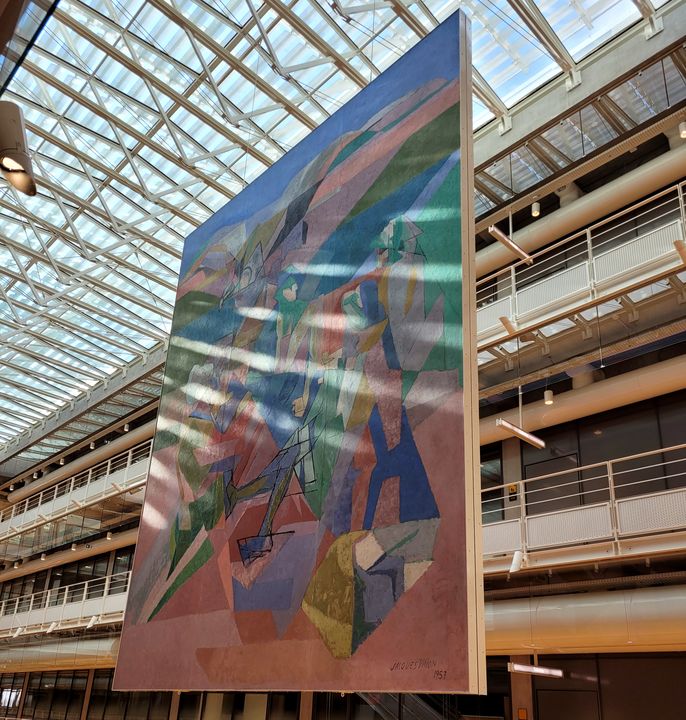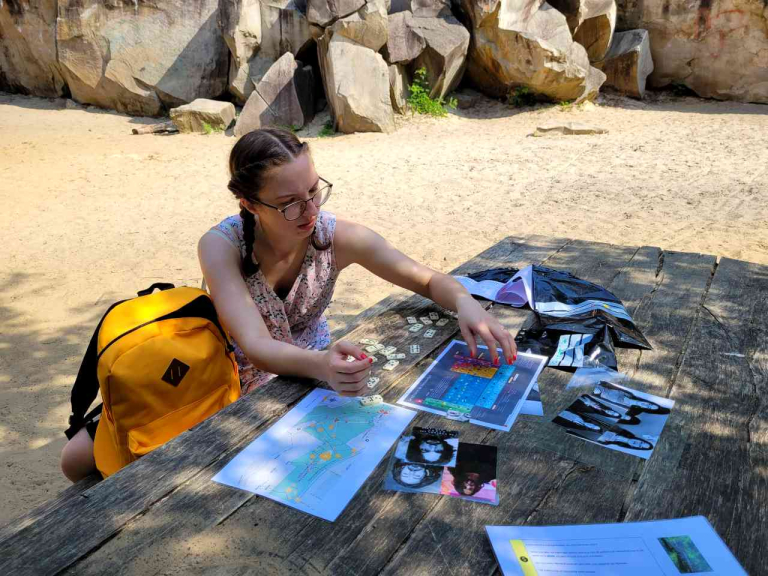
The Opera at the Ecole Normale Supérieure Paris-Saclay
We went to the École Normale Supérieure Paris-Saclay in Gif-sur-Yvette for an original experience. A tour of this prestigious school followed by a show, a contemporary opera. This experience was organised by the Scène de Recherche, which is the theatre on the school campus. I went with Ella and a small group of visitors, and we were curious to venture inside this establishment.

Clélia's experience
Promotion Manager
Destination Paris-Saclay
"I'm now actually envious of the students at the ENS..."
-
Gif-sur-Yvette
-
Duration: 3 hours

Renzo Piano, a renowned architect
We arrived in front of the impressive entrance to the ENS Paris-Saclay late afternoon. The sun was starting to set which created a great atmosphere here. The vast lobby with floor-to-ceiling windows was bathed in sunlight, and we could already see that it would be quite a nice experience to study here.
We were welcomed by Gaëlle, the communications manager for the Scène de Recherche. The tour could begin. The group gathered around a map of the school engraved into the floor and we immediately saw the sheer size of the building. It was designed in 2021 by the famous architect Renzo Piano. He is also behind the Centre Pompidou in Paris and The Shard in London. He's a real celebrity!
History of the Ecole Normale Supérieure
Gaëlle then told us a bit about the history of the Ecole Normale Supérieure. The school was founded in Paris in 1794 with the goal of training future generations of teachers. It expanded, became the Ecole Normale Supérieure and moved to Cachan in 1957. In 2020, after joining the Université Paris-Saclay, the ENS was then moved to the Plateau de Saclay in Gif-sur-Yvette. There are over 1,700 students and more than 300 teachers and researchers on this campus. Today, the ENS Paris-Saclay offers 11 courses (physics, chemistry, IT, biology, mathematics, civil engineering, mechanical engineering, Nikola Tesla, languages, humanities and design). What distinguishes the Écoles Normales Supérieures from other institutions is their practical science programmes, in teaching fundamental scientific concepts and their applications.

- Alain Aspect, physician and winner of the Nobel prize for physics in 2022.
- Guy-Rachel Grataloup, artist and painter. He is behind the Chevreuse Museum of Contemporary Art, the Musée Grataloup.
- Sylvie Retailleau, physician, Minister of Higher Education and Research (Borne government) and former President of the Université Paris-Saclay.

The tour of the ENS in Gif-sur-Yvette
After this introduction, we went up to the first floor to visit the big amphitheatre. We could easily picture the students here during their classes and exams.
Then we went across the walkway surrounded by floor-to-ceiling windows, overlooking the main entrance. We took a moment to admire the incredible view of the Moulon district and all the new buildings. We caught a glimpse of the CentraleSupélec building, maybe this could be our next tour!
On the next floor up we walked along the impressive walkway over the garden, to reach the Atrium. This is a superb space, designed in the style of a cloister with several floors of classrooms, workshops and laboratories. Dotted all over the place, we could see workstations, relaxation areas and modular rooms that could be adapted to individuals or groups.
Our tour was on a quiet day, because the students have activities outisde the school on Thursday afternoons. But we could easily imagine what this place was like with hundreds of students, teachers and researchers milling about in the atrium. At atmosphere worthy of Silicon Valley!


Percent for Art
Two huge artworks were hanging up above our heads, so we went up the stairs to be able to admire them up close. These monumental abstract paintings by Jacques Villon date from 1957 and are a part of the school's Percent for Art initiative.
There are artworks displayed in the various areas around the building. The colourful furniture we can see in the Atrium was created by a designer for example. There are some monumental artworks in the lobbies. Some artworks have been moved from the Cachan campus, such as the map of the former school and some statues in the garden.

“The expression of public desire to support creation and to increase awareness of contemporary art", "the obligation to decorate public facilities", known as the Percent for Art initiative, is a specific procedure whereby the State is obliged to purchase artworks for its public establishments and local authorities.”
To find out more: www.culture.gouv.fr/Thematiques/Arts-plastiques/Commande-artistique/Le-1-artistique
The school garden
The tour then led us into the garden. It is set at the centre of the building and is a real little haven of peace and serenity. The tour was then transformed into a botanical exploration. There is an incredible variety of tree and plant species in this garden and our group really enjoyed the tour. The way the garden has been designed is truly remarkable. There are so many different plants, colours, relaxing areas, ponds and artworks. Four ponds with bronze sculptures of animals or nature, including bats, seahorse, bramble and mushrooms.



![Scène de recherche, © [L]ens Amandine Oliveira Scène de recherche, © [L]ens Amandine Oliveira](https://www.destination-paris-saclay.com/uploads/2023/10/scene-de-recherche-lens-amandine-oliveira.jpg)
The Scène de Recherche theatre
The tour then came to an end and we were directed to the Scène de Recherche theatre. This is a professional theatre on the school campus. It is a place of creation where students benefit from training, research and then perform to the public.
We were served a glass of locally produced apple juice for a much-appreciated short break before the show. This was an opportunity to chat to the other members of the group. Some of them are regular participants on the tours we organise. Ella and I seized the opportunity to share some of our recommendations and talk about some of our upcoming projects.
Showtime! We were shown into the theatre and were surprised at how close the audience is to the stage. The musicians who would be playing live during the show were already in place. We listened to them tuning their instruments. We became silent when the theatre manager, Ulysse Baratin, came onto the stage to tell us about what we were about to see. The last phones were switched into airplane mode and the lights were dimmed.
A contemporary opera, Violet
The show began and we sat back to watch the opera, 'Violet'.
The set was very simple with a big table, two chairs and a serving trolley with platters and dishes. There were only three characters, a woman, her husband and their maid. The story was simple, time was ticking away, every day was an hour shorter until there was nothing left. We watched the characters as they experienced this tragedy in very different ways. Violet saw it as an opportunity to flee and decided to build a boat to get away.
The Opera was sung in English, and the lyrics had been translated at the ENS English department, and were displayed on the screen. The singers didn't need microphones, as their voices were powerful enough. We were so close to the stage so we could really appreciate their incredible talent.
We were drawn into this original story and the voices. When the show ended, the lights came back on and we were pulled back slowly into reality. We had a very interesting evening full of pleasant surprises. We can't wait to come back for another tour and a new show!



Practical
Information
SCÈNE DE RECHERCHE
École normale supérieure Paris-Saclay
4, avenue des Sciences
91190 Gif-sur-Yvette
Tel. 01 81 87 50 00
Website : ens-paris-saclay.fr/scene-de-recherche
Facebook : www.facebook.com/scenederecherche





